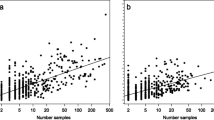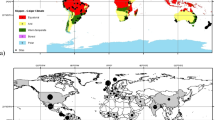Abstract
Leaf δ 13C of different plant functional groups (trees, shrubs and forbs; evergreen and deciduous; annual, biennial and perennial) were examined on the Changbai Mountains, China. Life form has a significant influence on plant δ 13C, suggesting that leaf δ 13C is also ideal for distinguishing functional groups species in temperate and frigid zones with high humidity. Additionally, the difference of water-use efficiency (WUE) is significant among different plant functional groups. δ 13C and WUE are in the following order of forbs < shrubs < trees. Within shrubs, δ 13C and WUE are higher for evergreen shrubs than deciduous shrubs. Differences in δ 13C and WUE are significant among different lifespan herbs, and δ 13C and WUE follow the order of annual herbs > biennial herbs > perennial herbs, not in accordance with the pattern obtained by previous studies in deserts, suggesting that the ranking of δ 13C and WUE among annual, biennial and perennial herbs may be dependent on local water availability.
Similar content being viewed by others
References
Shugart H H. Plant and ecosystem types. In: Smith T M, Shugart H H, Woodward F I, eds. Plant Functional Types: Their Relevance to Ecosystem Properties and Global Change. Cambridge: Cambridge University Press, 1997, 20–43
Domingues T F, Martinelli L A, Ehleringer J R. Ecophysiological traits of plant functional groups in forest and pasture ecosystems from eastern Amazônia, Brazil. Plant Ecol, 2007, 193: 101–112
Farquhar G D, O’Leary M H, Berry J A. On the relationship between carbon isotope discrimination and the intercellular carbon dioxide concentration in leaves. Aust J Plant Physiol, 1982, 9: 121–137
Farquhar G D, Richards P A. Isotopic composition of plant carbon correlates with water-use efficiency of wheat genotypes. Aust J Plant Physiol, 1984, 11: 539–552
Brooks J R, Flanagan L B, Buchmann N, et al. Carbon isotope composition of boreal plants: functional grouping of life forms. Oecologia, 1997, 110: 301–311
Watkins J M Jr, Rundel P W, Cardelús C L. The influence of life forms on carbon and nitrogen relationships in tropical rainforest ferns. Oecologia, 2007, 153: 225–232
Zheng S X, Shangguan Z P. Foliar δ 13C values of nine dominant species in the loess Plateau of China. Photosynthetica, 2007, 45: 110–119
Ehleringer J R, Cooper T A. Correlations between carbon isotope ratio and microhabitat in desert plants. Oecologia, 1988, 76: 62–66
Lauteri M, Brugnoli E, Spaccino L. Carbon isotope discrimination in leaf soluble sugars and in whole plant dry matter in Helianthus annuus L. grown under different water conditions. In: Ehleringer J R, Hall A E, Farquhar G D, eds. Stable Isotope and Plant Carbon-Water Relations. San Diego: Academic Press, 1993. 93–108
Schuster W S F, Sandquist D R, Phillips S L, et al. Comparisons of carbon isotope discrimination in populations of aridland plant species differing in lifespan. Oecologia, 1992, 91: 332–337
Su B, Han X G, Li L H, et al. Responses of δ 13C value and water use-efficiency of plant species to environmental gradients along the grassland zone of Northeast China Transect (in Chinese). Acta Phytoecol Sin, 2000, 24(6): 648–655
Peñuelas J, Filella I, Terradas J. Variability of plant nitrogen and water use in a 100-m transect of a subdesertic depression of the Ebro valley (Spain) characterized by leaf δ 13C and δ 15N. Acta Oecol, 1999, 20: 119–123
Garten C T, Taylor G E. Foliar δ 13C within a temperate deciduous forest: spatial, temporal, and species sources of variation. Oecologia, 1992, 90: 1–7
Kloeppel B D, Gower S T, Treichel I W, et al. Foliar carbon isotope discrimination in Larix species and sympatric evergreen conifers: a global comparison. Oecologia, 1998, 114: 153–159
Marshall J D, Zhang J. Carbon isotope discrimination and water-use efficiency in native plants of the north-central Rockies. Ecology, 1994, 75: 1887–1895
Smedley M P, Dawson T E, Comstock J P, et al. Seasonal carbon isotope discrimination in a grassland community. Oecologia, 1991, 85: 314–320
Hinckley T M, Brooks J R, Cermak J, et al. Water flux in a hybrid poplar stand. Tree Physiol, 1994, 14: 1005–1018
Hollinger D Y, Kellher F M, Schulze E D, et al. Coupling of tree transpiration to atmospheric turbulence. Nature, 1994, 37: 160–162
Parker G G. Structure and microclimate of forest canopies. In: Lowman M D, Nadkarni N M, eds. Forest Canopies. San Diego: Academic Press, 1995. 73–106
Panek J A, Waring R H. Carbon isotope variation in Douglasfir foliage: improving the δ 13C-climate relationship. Tree Physiol, 1995, 15: 57–663
Walcroft A S, Silvester W B, Grace J C, et al. Effects of branch length on carbon isotope discrimination in Pinus radiate. Tree Physiol, 1996, 16: 281–286
Brooks J R, Flanagan L B, Varney G T, et al. Vertical gradients of photosynthetic gas exchange and refixation of respired CO2 within boreal forest canopies. Tree Physiol, 1997, 117: 1–12
Schulze E D. Plant life forms and their carbon, water, and nutrient relations. In: Plant Physiological Ecology II. Berlin Heidelberg New York: Springer, 1982. 615–676
Chabot B F, Hicks D J. The ecology of leaf life spans. Annu Rev Ecol Syst, 1982, 13: 229–259
Körner C H. Leaf diffusive conductance in the major vegetation types of the globe. In: Schulze E D, Caldwell M M, eds. Ecophysiology of Photosynthesis (Ecological Studies 100). Berlin Heidelberg New York: Springer, 1994. 463–490
Reich P B, Kloeppel B D, Ellsworth D S, et al. Different photosynthesis- nitrogen relations in deciduous hardwood and evergreen coniferous tree species. Oecologia, 1995, 104: 4–30
Author information
Authors and Affiliations
Corresponding author
Additional information
Supported by National Natural Science Foundation of China (Grant No. 40472159)
About this article
Cite this article
Tan, W., Wang, G., Han, J. et al. δ13C and water-use efficiency indicated by δ13C of different plant functional groups on Changbai Mountains, Northeast China. Chin. Sci. Bull. 54, 1759–1764 (2009). https://doi.org/10.1007/s11434-009-0046-1
Received:
Accepted:
Published:
Issue Date:
DOI: https://doi.org/10.1007/s11434-009-0046-1




